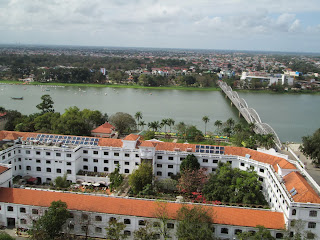 Hué
Hué
The city is located in central Vietnam on the banks of the Perfume River just a few miles inland from the South China Sea.
From 1802 to 1945, Hué was the imperial capital of the Nguyen Dynasty, a feudal dynasty which dominated much of southern Vietnam from the 17th to the 19th century.
In 1945,the Japanese, who had been occupying IndoChina, surrendered to the Allies. The Emperor at the time, Bao Dai, was persuaded by the leader of the Vietminh, Ho Chi Minh, to abdicate and a communist government was established in Hanoi in the north. While Bảo Đại was briefly proclaimed "Head of State" with the help of the returning French colonialists in 1949, his new capital was Saigon in the south.

During the Vietnam war, Huế’s central location very near the border between the North and South put it in a vulnerable position. The city went through tough times, when it was conquered by the Viet Cong during the Tet offensive and held for 24 days. During that time, Communist forces slaughtered around 4,000 civilians suspected of sympathizing with the South, being a high school graduate or Christian. In retaking the city American forces initially didn't use artillery or air support to avoid damaging ancient buildings but due to heavy casualties these restrictions were relaxed and the city largely destroyed.
After the war’s conclusion, many of the historic features of Huế were neglected because they were seen by the victorious regime as ‘relics from the feudal past’. There has since been a change of policy, however, and many historical areas of the city are currently being restored.
 |
| Citadel Flag Tower |
 |
Paul looking toward to Citadel on the
Trang Tien Bridge over the Perfume River |
 |
Across the moat and through the Ngan Gate, above,
brings you to the main entrance of the Citadel. |
 |
Ngo Mon Gate at the main entrance to the Citadel
|
The Citadel
The seat of government of the Nguyễn emperors was the Citadel, a great sprawling complex of temples, pavilions, moats, walls, gates and palaces.
 |
gateway on Trung Dao (Central Path), carved with dragons
slithering up and down the columns. |
The citadel was badly damaged during fighting between the French and the Viet Minh in 1947, and again in 1968 during the Tet Offensive. As a result, some areas are now only empty fields, bits of walls, and an explanatory plaque. Other buildings are intact and a few are in good condition.
The fortress included three enclosures: the Civic, Imperial and Forbidden Purple Cities. The Imperial City has seen the most restoration.
 |
| Paul in front of the Thai Hoa Palace. This was the grand throne palace of the Nguyen Emperors. |
Beautifully carved golden dragons
(right), the emblem of the Nguyen
Dynasty, can be found everywhere: on, columns, in courtyards, on rooftops.
 |
| Part of the Dien Tho Palace, or residence of Everlasting Longevity, home to the Queen Mothers. |
Within the Imperial City, now mostly an open stretch of land, was the Forbidden Purple City. Only the emperors, concubines, and those close enough to them were granted access to the Forbidden Purple City; the punishment for trespassing was death.
 |
Inside the Royal Theatre, built in 1826. The columns are lacquered with more golden dragon carvings.
The Theatre is still used for traditional performances of court music. |
One of the many ponds, stocked with koi and artistically decorated with rock formations, plants and miniature pagodas and other structures, found to the east of the palace.
 |
| We came across this elephant in one of the open areas where nothing but rubble is left of the former structure. |
 Royal Tombs
Royal Tombs To the south of Hué, there are seven tombs of Nguyen Emperors. The tomb of Khai Dinh, the last Emperor to be buried in a royal tomb at Hué, is the least traditional.
 |
| The Tomb of Khai Dinh is built into the side of a hill requiring a climb of 137 steps to reach the actual tomb. |
 |
| More dragons vivible on either side of the stairs. |
There are 2 rows of stone statues, facing the centre of the court, on a landing below the burial tomb. The statues represent the Emperor's bodyguard.
In the temple at the summit, there is a bronze bust and photo of Emperor Khai Dinh, who ruled until 1925.
Khai Dinh had spent some time in France, so this tomb, uncharacteristically, used concrete and attempted to fuse Vietnamese and European Architectural styles. It took 11 years to build.
Thien Mu Pagoda Located on a hill above the Perfume River, the Thien Mu Pagoda or Heavenly Lady Pagoda, was built in 1601 by one of the Nguyen Lords.
 |
The Thap Phuoc Duyen, or Source of Happiness
Tower is a seven story, octagonal symbol of Hué. |
 |
| Paul with one of the ten Kings of Hell. |
 |
| This blue Austin belonged to Buddhist Monk, Thich Quang Duc. Thich drove this car to Saigon in June 1963 where he went to the middle of a busy intersection and set himself on fire to protest the Diem regime, the government of South Vietnam at the time. |
Paul made me climb the tree for this picture, taken in the gardens of the Thien Mu Pagoda.
 |
| Renting a scooter is a great way to see the Royal Tombs and Pagodas. |









































